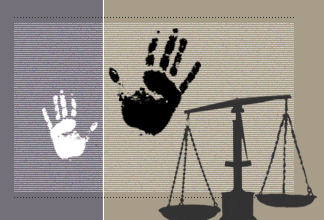When I agreed to write about affirmative action for The Public Humanist, I realized quickly that the big challenge was to present this hot issue in a humanistic way. What does it mean to write about a political controversy as a humanist?
 Karl Marx said that the point is not to interpret the world but to change it (Theses on Feuerbach, no. 11). I don’t agree with that. The important thing is to better one’s understanding. Any change that occurs through humanistic reflection comes indirectly, from the new interpretations of reality it supplies, not from pursuing change for its own sake.
Karl Marx said that the point is not to interpret the world but to change it (Theses on Feuerbach, no. 11). I don’t agree with that. The important thing is to better one’s understanding. Any change that occurs through humanistic reflection comes indirectly, from the new interpretations of reality it supplies, not from pursuing change for its own sake.
Taking a humanistic approach to affirmative action means representing the whole debate about the issue, not choosing sides that have already been taken inside the debate. The true humanist tries to deepen the public’s understanding by removing issues from their conventional polemical setting and exploring them in unexpected frameworks. 
In the humanities we have many different methods of interpretation, but I will offer just one here: the comparative method.
Baron Montesquieu, the French nobleman who wrote The Spirit of the Laws (1748) said that the capacity to compare was the greatest faculty of the human mind. Another profound comparative thinker, Alexis de Tocqueville, author of Democracy in America (2 vols., 1835-1840), said, “The mind can gain clarity only through comparison.”
Comparison can be local or global. Locally, I observe a remarkable divergence here in the town of Amherst. UMass, the big public university where I teach, has no affirmative action for student admissions; Amherst College, a small elite private college, does have affirmative action. This is a paradox. If affirmative action is supposed to compensate for past injustices, such as slavery, then shouldn’t our public institutions be at the forefront of atoning for our collective sins?
This paradox comes out of our constitutional system. The amendments to the Constitution that were added shortly after the Civil War, amendments designed to ban slavery and racial  discrimination, applied to state governments, not to private institutions. That’s because racial inequality had been implemented through state law that classified people on the basis of color. Today, the standard argument against affirmative action is that it’s a form of reverse discrimination—it continues governmental classification of people on the basis of race. Our constitutional law is basically indifferent to whether private organizations do this, but it will not permit state institutions to impose a rigid scheme of racial classification on people, even to help minorities. Hence, you will find that the most vigorous forms of affirmative action in universities today are done in private universities. Public institutions may practice affirmative action within limits. But since it’s not entirely clear what these limits are—When does legitimate affirmative action become unlawful racial profiling?—many state universities avoid the risk of being sued for racial discrimination by not practicing affirmative action at all.
discrimination, applied to state governments, not to private institutions. That’s because racial inequality had been implemented through state law that classified people on the basis of color. Today, the standard argument against affirmative action is that it’s a form of reverse discrimination—it continues governmental classification of people on the basis of race. Our constitutional law is basically indifferent to whether private organizations do this, but it will not permit state institutions to impose a rigid scheme of racial classification on people, even to help minorities. Hence, you will find that the most vigorous forms of affirmative action in universities today are done in private universities. Public institutions may practice affirmative action within limits. But since it’s not entirely clear what these limits are—When does legitimate affirmative action become unlawful racial profiling?—many state universities avoid the risk of being sued for racial discrimination by not practicing affirmative action at all.
This is a stark contrast to other countries where affirmative action, if it’s practiced at all, is supervised by the state, not private organizations. So I turn now from local comparison to international comparison. There are some democratic countries that practice affirmative action; and these usually modify their constitutions in order to make it clear that affirmative action is  going to be an exception to the general principles of equality and non-discrimination. The Constitution thus carves out a niche for affirmative action. Then there are other democratic countries whose constitutions do not explicitly approve of affirmative action; these countries generally reject affirmative action vehemently as a plain violation of the spirit of equality. The curious thing is that the U.S. is in between. Affirmative action is not mentioned in the Constitution, but in the landmark 1986 Bakke case, the Supreme Court established that while “quotas” are illegal, certain types of preference for minority groups are nevertheless compatible with the Constitution. This is a hybrid situation. Our highest authority, the text of the Constitution, doesn’t lend itself easily to affirmative action. In fact, affirmative action looks like a violation of the Fourteenth Amendment, which speaks of “equal protection of the laws.” But our most respected interpreter of the document, the Supreme Court, says affirmative action is okay, sometimes.
going to be an exception to the general principles of equality and non-discrimination. The Constitution thus carves out a niche for affirmative action. Then there are other democratic countries whose constitutions do not explicitly approve of affirmative action; these countries generally reject affirmative action vehemently as a plain violation of the spirit of equality. The curious thing is that the U.S. is in between. Affirmative action is not mentioned in the Constitution, but in the landmark 1986 Bakke case, the Supreme Court established that while “quotas” are illegal, certain types of preference for minority groups are nevertheless compatible with the Constitution. This is a hybrid situation. Our highest authority, the text of the Constitution, doesn’t lend itself easily to affirmative action. In fact, affirmative action looks like a violation of the Fourteenth Amendment, which speaks of “equal protection of the laws.” But our most respected interpreter of the document, the Supreme Court, says affirmative action is okay, sometimes.
 A great example of a nation whose constitution explicitly advocates affirmative action is India. Article 14 of India’s Constitution seems to be based on the Fourteenth Amendment of our text. The Indian document says, “The State shall not deny to any person equality before the law or the equal protection of the laws.” Article 15 prohibits discrimination on the basis of religion, race, caste, and sex. However, an extra clause in this article says, “Nothing in this article?shall prevent the State from making any special provision for the advancement of any socially and educationally backward classes of citizens or for the Scheduled Castes and the Scheduled Tribes.” So there it is—affirmative action, right in the Constitution. Clearly, the framers of the text realized that the document’s general emphasis on equality and non-discrimination would tend to make affirmative action illegal. So they folded into the document an affirmative-action caveat.
A great example of a nation whose constitution explicitly advocates affirmative action is India. Article 14 of India’s Constitution seems to be based on the Fourteenth Amendment of our text. The Indian document says, “The State shall not deny to any person equality before the law or the equal protection of the laws.” Article 15 prohibits discrimination on the basis of religion, race, caste, and sex. However, an extra clause in this article says, “Nothing in this article?shall prevent the State from making any special provision for the advancement of any socially and educationally backward classes of citizens or for the Scheduled Castes and the Scheduled Tribes.” So there it is—affirmative action, right in the Constitution. Clearly, the framers of the text realized that the document’s general emphasis on equality and non-discrimination would tend to make affirmative action illegal. So they folded into the document an affirmative-action caveat.
A great example of a nation whose constitution does not endorse affirmative action is France. Article 2 of the French document says, “France is an indivisible, secular, democratic, and social Republic. It ensures the equality of all citizens before the law, without distinction as to origin, race, or religion.” In France, there is a very wide consensus that this precludes affirmative action on the basis of race. In fact, in France it is illegal for the government to categorize people according to their racial or ethnic origins. Censuses cannot collect information on ancestry. French statistics are forbidden to have any references concerning ethnic membership.”

Though the French are against affirmative action on the basis of race, they’ve recently become enthusiastic about affirmative action for females running for political office. The political parties are now required to slate a certain number of females as their candidates in elections. This policy is known as “parity.” Recognizing that this is a kind of affirmative action, and that it looks inconsistent with the principle of non-discrimination, the French dampened the contradiction by amending their Constitution. In 1999, they added a phrase to the Constitution stating that the law shall favor women’s “access” to electoral offices.
In sum, nations generally perceive affirmative action as a conceptual problem in relationship to equality—because it is outside the norm of equality. If they want to practice affirmative action anyway, they establish in their constitutions that affirmative action is going to be an exception to the general rule of equal treatment. The U.S. lacks this  constitutional source of authority for affirmative action. I believe this explains why there is so much philosophical agony over the legitimacy of affirmative action in our country, and why even supporters of affirmative action often seem confused about how to articulate the rationale for affirmative action. In the Bakke case, the distinction between working with a quota system and merely giving a minority extra points in the competitive process is not clear. After all, both involve classifying people on the basis of race. Also, the justices who supported affirmative action in the case had entirely different conceptions of how it can be squared with the principle of non-discrimination. Some perceived affirmative action as a remedy for past discrimination. But others refused to take this approach and spoke instead of “diversity” as the goal of affirmative action. The Bakke case actually contains six separate judicial opinions. Many commentators have observed that they don’t overlap in a manner that signals a clear majority among the justices. More recent affirmative cases, instead of resolving this confusion, have only demonstrated the ongoing lack of consensus.
constitutional source of authority for affirmative action. I believe this explains why there is so much philosophical agony over the legitimacy of affirmative action in our country, and why even supporters of affirmative action often seem confused about how to articulate the rationale for affirmative action. In the Bakke case, the distinction between working with a quota system and merely giving a minority extra points in the competitive process is not clear. After all, both involve classifying people on the basis of race. Also, the justices who supported affirmative action in the case had entirely different conceptions of how it can be squared with the principle of non-discrimination. Some perceived affirmative action as a remedy for past discrimination. But others refused to take this approach and spoke instead of “diversity” as the goal of affirmative action. The Bakke case actually contains six separate judicial opinions. Many commentators have observed that they don’t overlap in a manner that signals a clear majority among the justices. More recent affirmative cases, instead of resolving this confusion, have only demonstrated the ongoing lack of consensus.

The American approach to affirmative action is fractured between literal readers of the Constitution who oppose affirmative action, and social reformers who defend affirmative action but do not agree even among themselves on how to square racial preferences with the Equal Protection clause of the Fourteenth Amendment. Our entire discourse on affirmative action is pained by this contradiction between our constitutional text and our efforts to reform society in pragmatic ways. The result is that we have a social ideal (to have more minorities in our universities) that public educational institutions are afraid to act upon, for fear of violating our political ideals (equality as defined in the Constitution). From a comparative viewpoint, this is a really odd state of affairs. The appropriate remedy, in light of this analysis, may well be to discontinue affirmative action in all public institutions until we agree that affirmative action is important to enough to deserve a mention in our Constitution.
–Daniel Gordon, Professor of History, UMass Amherst


